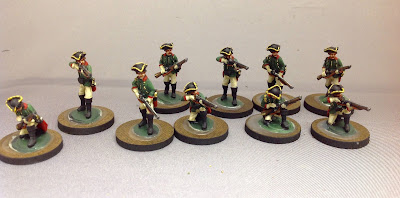 |
| The Prussian encampment at Hochkirch. |
I have seen some really good looking wargame tabletop terrain mats at conventions over the past couple of years. They are made by a company called Cigar Box Battle. The mats have images of roads, fields and woods pre-printed onto a cloth material (baize perhaps?). The result is a very realistic game mat that will greatly enhance the look of any game table.
Here are two views of the mats; first, the Before view of just the mats and the After view after I have placed some terrain pieces on top of the mat. The set of trees on the right hand side are located approximately at the place where the two mats are joined together to create one 6ft by 10ft table.
 |
| The "Before" picture of the two mats lined up together. |
 |
| The "After" picture with the addition of my own trees, houses and other terrain pieces. |
Click on the link below to go to the company's web store:
I have admired Cigar Box mats for quite awhile but I wasn't sure that I wanted to ditch my existing table mat and start over with a whole new system. My main concern was that with the roads already layed out that it would restrict my games to the particular type of terrain that is on the mat.
However, my recent interest in playing skirmish level wargames made me rethink my stance and I decided to go ahead and buy a pair of mats to use for skirmish games. Once I had a chance to look at these mats first hand on my table, any concerns that I had evaporated. It is an easy matter to lay your own terrain on top of the mat - so if a corn field is in the way, you can simply place a building on top of the field, sprinkle a few bits of lichen on the mat, and then Bob's your uncle, you are good to go.
Sizes
The mats are available for a variety of figure sizes (such as 10mm, 15mm and 28mm, etc.) I purchased two mats of European terrain that come with wide roads suitable for 28mm figures and vehicles. The mats measure 6ft by 4ft but are actually closer to 6ft by 5ft. As a result, I can put the two halves together and have a 6ft by 10ft table.
The two mats that I bought are called New Europe #510 and New Europe 2 #660 (both with wide roads). The roads and fields are designed to match up with each other for these two selections. I believe that there is also a mat that is all green ground cover without roads and other preprinted terrain areas. You could buy a pair of these if you are concerned about having your games boxed in with what is printed on the mat.
 |
| A T-intersection on the mat, graced with a Saxony-style house and a guarded checkpoint. |
 |
| Downtown Hochkirch at rush hour. The citizens converge on the inn, on the left, for Happy Hour. |
Best Features
(1) Ease of transport - In my opinion, the best feature of the mats is that they are easy to roll up or fold up for transport. In fact, folding the mats does not seem to create any fold marks on the mat, which is a big plus. These are light weight compared to my canvas terrain mat and because you can fold them, they will take up so much less room in my car when I am taking a game to a convention.
(2) Realistic appearance - Another feature that I like is the detail and realism of the printed fields, etc. They almost have a 3D effect, so when I look at a ploughed field from afar, it really looks like a 3D ploughed field. Perhaps the best part of this though, is the sense of realism - when you are out driving in the countryside you see variety in the types of field - some have plantings, some are fallow fields at rest without plantings, some green grazing areas, etc. When you put them all together, you see a wonderful mosaic of diverse terrain on your table top, rather than seeing vast areas of unadorned green felt (or in my case, green canvas).
(3) Flexability - Once you spread your mat over the game table, then place your own terrain pieces on top of the mat. For example, there are obvious places that represent woods, so plop down your trees in that area. For ploughed ground, add a farmer or two. For a fallow field, place a few cows or sheep etc.
 |
| Prussian field bakery. The bakery models hide the underlying ploughed field. You would never know that it was there. |
 |
| Another view of the field bakery. |
 |
| Lots of things are happening inside the Prussian camp. |
As you might probably guess by now, I really like my Cigar Box (I like the company's name) mats and plan to use them for both skirmish and larger scale battles. I like my existing terrain system, but the new mats will "up my game" in my opinion.







































